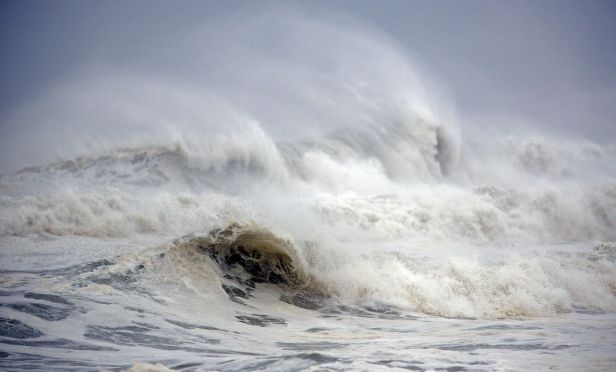 Waves break ahead of Hurricane Michael in Panama City Beach, Florida, on Wednesday, Oct. 10, 2018. (Photo: Luke Sharrett/Bloomberg)
Waves break ahead of Hurricane Michael in Panama City Beach, Florida, on Wednesday, Oct. 10, 2018. (Photo: Luke Sharrett/Bloomberg)
Updated: 2 p.m. ET
(Bloomberg) — Hurricane Michael made landfall on the Florida Panhandle Wednesday, with 155 mile-per-hour winds establishing it as the strongest storm to hit the continental U.S. since 2004.
Michael is expected to batter Panama City and nearby areas with a potentially deadly 14-foot storm surge, according to the latest National Hurricane Center update. The swift-moving monster is set to drop as much as 12 inches of rain in some areas as it races north toward Georgia, Alabama and a Carolinas region still recovering from Hurricane Florence.
"A storm like this could be a once-in-a-lifetime event," said Brett Rathbun, a meteorologist with AccuWeather Inc. in State College, Pennsylvania. "Winds of this intensity can really knock down any tree or structure in its path."
Landfall near Mexico Beach, Florida
The storm made landfall near Mexico Beach, Florida, the Hurricane Center reported. As much as 40% of oil production in the Gulf of Mexico and 28% of natural gas output was shut down as the storm pushed toward land. Regional ports are closed, and almost 300 flights have been canceled. About 104,000 homes and businesses lost power before the storm made landfall.
As a Category 4 storm, Michael is the most intense to make landfall on the panhandle in U.S. records dating back to 1851, with the last major hurricane, Dennis, arriving as a Category 3 in 2005. The last storm to batter the mainland at Michael's strength was Hurricane Charley in 2004, which hit Florida's West Coast about 90 miles south of Tampa.
In September, Hurricane Florence's winds peaked at 137 miles per hour off the U.S. coast, but dropped in intensity prior to the storm's landfall in the Carolinas. Now known more for its rains than the strength of its winds, Florence caused devastating floods, killed at least 39 and caused about $45 billion in estimated damages.
Michael, hitting in a less populated area, is "a different monster than Florence," AccuWeather's Rathbun said. Rather than lingering in one region as Florence did, inundating the Carolinas with rain, Michael is expected to race north to Georgia by Thursday, and reach the coast of Massachusetts by the weekend, he said.
Evacuation orders for about 375,000
About 375,000 people live in areas covered by local evacuation orders.
The storm may weaken after landfall as it moves across the southeastern U.S. before reemerging over the Atlantic, the hurricane center said in its advisory. Damage from the storm could reach $16 billion, depending on its intensity after landfall and how quickly it moves through the region, according to Chuck Watson of Enki Research in Savannah, Georgia, with Panama City taking the hardest hit.
"Michael is definitely shaping up to be a classic hurricane," Watson said by email. "So the estimates are a bit more stable since you don't have the stall and wander problem" that made Hurricane Florence hard to calculate.
Agriculture markets, meanwhile, were shrugging off the storm. Prices for cotton, soybean and corn crops fell on Tuesday, as did orange juice futures. "Hurricanes are nearly always a 'buy the rumor, sell the fact' scenarios," Louis Rose, the director of research and analysis a Rose Commodity Group, in Memphis, Tennessee, said by email.
14 named Atlantic storms so far this year
While the panhandle is more sparsely populated than many other areas of Florida, it includes the capital city of Tallahassee, Pensacola and Panama City. The Atlantic has produced 14 named storms this year. They include Florence and Tropical Storm Gordon, which made landfall on the Alabama-Mississippi border last month.
Here's the latest on the storm's effects:
- The Coast Guard Tuesday closed ports at Gulfport and Pascagoula in Mississippi, Mobile in Alabama, and Panama City and Pensacola in Florida, and restricted vessel traffic on the Intracoastal Waterway.
- Total insured losses for Hurricane Michael should be manageable and have minimal impact on property reinsurance pricing, Keefe, Bruyette & Woods Inc. analyst Meyer Shields wrote in a note.
Original 12:32 p.m. story
(Bloomberg) – Hurricane Michael is battering the Florida Panhandle with high winds and rain, the first salvo of a storm poised to be the strongest to hit the continental U.S. since 2004.
150 mph winds
Michael is about 40 miles (64 kilometers) south of Panama City, generating 150 mile-per-hour winds and moving northward at a 14 mile-per-hour clip, according to the latest National Hurricane Center update. The swift-moving monster is set to make landfill in early afternoon as the most intense storm ever to hit the panhandle region.
Instant Insights: Hurricanes & insurance in 2018
The storm has already cut Gulf of Mexico oil production by 40% and natural gas output by 28%. Regional ports are closed, and about 280 flights have been canceled. About 40,000 residents had lost power as of 11:45 a.m., with Duke Energy Corp. predicting as many as 200,000 outages once the storm's center arrives.
'Once-in-a-lifetime event'
"A storm like this could be a once-in-a-lifetime event," said Brett Rathbun, a meteorologist with AccuWeather Inc. in State College, Pennsylvania. "Winds of this intensity can really knock down any tree or structure in its path."
The storm is churning 28-foot waves in the Gulf, and could bring a 14-foot surge and 4 to 8 inches of rain once it makes landfall, with some isolated areas getting as much as 12 inches. Water levels on the coast are already rising quickly, with a station near the city of Apalachicola recording water rising almost 5.5 feet above ground level.
"This is the final call," said Brock Long, administrator for the Federal Emergency Management Agency, or FEMA, in a briefing Wednesday morning. "Those who stick around to experience storm surge don't typically live to tell about it."
Most intense to make landfall on panhandle since records began
As a Category 4 storm, Michael would be the most intense to make landfall on the panhandle in U.S. records back to 1851, with the last major hurricane, Dennis, arriving as a Category 3 in 2005.
While Hurricane Florence's winds peaked at 137 miles per hour off the U.S. coast, they dropped in intensity prior to the storm's September landfall in the Carolinas, and it's known more for its rains than the strength of its winds. Florence caused devastating floods, killing at least 39 and causing about $45 billion in estimated damages.
Michael "will be a different monster than Florence," AccuWeather's Rathbun said. Rather than lingering in one region as Florence did, inundating the Carolinas with rain, Michael is expected to race north to Georgia by Thursday, and reach the coast of Massachusetts by the weekend, he said.
The storm may weaken after landfall as it moves across the southeastern U.S. before reemerging over the Atlantic, the hurricane center said in its advisory.
Early estimate of $16B in damages
Damages from the storm could reach $16 billion, depending on its intensity after landfall and how quickly it moves through the region, according to Chuck Watson, of Enki Research in Savannah, Georgia, with Panama City taking the hardest hit.
"Michael is definitely shaping up to be a classic hurricane," Watson said by email. "So the estimates are a bit more stable since you don't have the stall and wander problem" that made Hurricane Florence hard to calculate.
Agriculture markets, meanwhile, were shrugging off the storm. Prices for cotton, soybean and corn crops fell on Tuesday, as did orange juice futures. "Hurricanes are nearly always a 'buy the rumor, sell the fact' scenarios," Louis Rose, the director of research and analysis a Rose Commodity Group, in Memphis, Tennessee, said by email.
Tallahassee, Pensacola & Panama City in Michael's path
While the panhandle is more sparsely populated than many other areas of Florida, it includes the capital city of Tallahassee, Pensacola and Panama City.
The Atlantic has produced 14 named storms this year. They include Florence and Tropical Storm Gordon, which made landfall on the Alabama-Mississippi border last month.
Here's the latest on the storm's effects:
- The Coast Guard Tuesday closed ports at Gulfport and Pascagoula in Mississippi, Mobile in Alabama, and Panama City and Pensacola in Florida, and restricted vessel traffic on the Intracoastal Waterway.
- Total insured losses for Hurricane Michael should be manageable and have minimal impact on property reinsurance pricing, Keefe, Bruyette & Woods Inc. analyst Meyer Shields wrote in a note.
Related: Top 10 states at risk of hurricane storm surge damage in 2018
© 2024 ALM Global, LLC, All Rights Reserved. Request academic re-use from www.copyright.com. All other uses, submit a request to [email protected]. For more information visit Asset & Logo Licensing.








